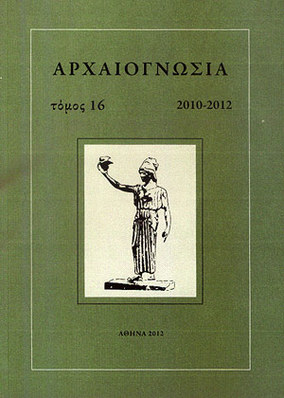Γλυπτά από μια Αθηναϊκή Έπαυλη του 3ου αι . μ.Χ.
Part of : Αρχαιογνωσία ; Vol.15, No.1-3, 2007, pages 163-188
Issue:
Pages:
163-188
Parallel Title:
Sculptures from an Athenian villa of the 3rd cent. A.C.
Section Title:
Μελέτες - Articles
Abstract:
Inside the city wall, on the road leading to Phaleron, an urban villa was discovered, which was destructed at the second half o f the 3rd century A.C., by the I lerulian invasion in 267 A.C. and had never been restored. The pottery and various movable finds indicate that the villa was repaired after a first destruction at the second or early third century A.C. In these destruction layers were collected the following reliefs and statuettes. A Roman statuette of Cybele was found on the floor, in front o f the west wall of a room of the villa, north o f the staircase in the destruction layer o f the 2nd or early 3rd century A.C. The goddess is enthroned, holding probably a tambourine (tympanum) in her left hand and a libation bowl (phiale) in her right, while being escorted by her favourite animal, the lion. In addition a marble relief showingCybele in a naiskos at the same type with the statuette of Cybele, dated to the 2nd century A.C., was found on the floor, in front o f the west wall o f a room o f the villa, at the northwest angle of the collonade around the court (περιστύλιον). According to the excavated invents, it is very possible that the statuette of Cybele served thehousehold shrine -which was probably dedicated to Cybele/Mother o f the Cods- at the first phase o f this Roman villa, while at the second phase, after the first and until the final destruction, the same role was assumed by the naiskos o f Cybele. The Mother of the Gods is the mistress of nature, governess of the cosmic and civic order and protector o f family and setdements. She was introduced in Athens in the late fifth century B.C. and until the fourth century A.C. enjoyed cult in sanctuaries according to movable finds and inscriptions. A part of a votive relief was found in the destruction layer o f die 2nd or early 3rd century A.C., at the southeast part of the villa. It shows three adorants to the right, a man, a child and a woman, probably a family. Between the male and the female figures, arc depicted two busts of old men to the right, probably the dead ancestors. It was probably dedicated to Asklepios or to the Mother of the Gods. The archaeological evidence certifies that the common cult of Asklepios and Cybele continues until the Imperial period. The dating of this relief is very difficult, because we do not know any parallels from other places o f the ancient world. It seems possible that it is an earlier monument and was either part of the decoration of the domestic sanctuary o f Cybele in this villa or was used as building material. A Part of Torso of a marble statuette of Aphrodite “pudica", dated to the late Antonine or Severine period, was found in a layer of fire at a corridor of the villa, at the north side o f the domestic sanctuary. In addition, a head of a female statue - probably Artemis - dated at the early Antonine period was found in a fill at the northwest part o f the villa. These two statues were probably consisting part of the sculptural decoration o f this Roman villa. In Roman times, statuettes of small dimensions, either served domestic sanctuaries or decorated urban villas. Aphrodite, the goddess of love, happiness and fertility and Artemis, the goddess of hunting and protector o f social and civic life, were very popular during the Imperial period.
Subject:
Subject (LC):
Keywords:
Γλυπτά, Αθηναϊκή Έπαυλη, 3ος αιώνας




